As a trained painter Portuguese visual artist Sónia Aniceto rebelled against smooth surfaces, always looking for shape, height and a tactile experience.
Sónia moved to the vibrant city of Brussels as part of her postgraduate studies and went on to work in the set décor studios of La Monnaie opera house. Working with textiles gave her the tactile aspect that she was looking for and so she began to develop her mixed media techniques, deftly integrating paint and thread in a fluid language where each becomes indistinguishable from the other.
After receiving a degree in painting and tapestry at the University of Lisbon, Portugal, she participated in the Socrates/Erasmus student exchange programme at the Academy of Fine Arts in Brussels (2000) and she qualified as a teacher of Fine Arts in 2005. She received a nomination for the Prémios Talento in Visual Arts, organised by the Ministry of Foreign Affairs, Portugal, in 2007. Sónia has taught in an art school since 2006 and provides art workshops for children with the international organisation Mus-e.
A regular attendee of international contemporary art fairs across Europe, Sónia also exhibits regularly in galleries throughout Europe and in the USA. Her latest solo exhibition “Peaux rebelles” was held at the Martine Ehmer Gallery, Brussels (2019) and this year she took part in and co-created a collaborative artistic residency project “Tanto Mar/Tant de Mer”, as part of the Espirito Mundo cultural exchange project at SeeU, Brussels. She will be exhibiting later this year at Contextile, the Contemporary Textile Art Biennale in Guimarães, Portugal (2020).
In this interview, you’ll be treated to Sónia’s sumptuous oil paintings fused with thread, classical yet simultaneously contemporary and unsettling. You’ll also discover more about how she works with ‘drop paper’ and free machine embroidery. The thick, fibrous paper is transformed into sinuous and shaped fabric forms, resembling animal hide or skin. The folds and curves created by the sewing machine allow the material to undulate into exciting three-dimensional forms.

A mix of paint and thread
TextileArtist.org: What initially attracted you to textiles as a medium? How was your imagination captured?
Sónia Aniceto: I’ve always had the urge to express myself by drawing and painting. Working with textiles came later, almost like a hidden genetic inheritance. The women in my family (my mother, aunt and grandmother) embroidered or made lace and as a teenager I was fascinated by the repetitive, almost mechanical gestures that seemed to hypnotise them. On the other hand, these exclusively feminine tasks seemed to contain women in their role of housewife, and that repelled me. I didn’t want to take part in it.
While I was at the University of Lisbon’s Faculty of Fine Arts, I had an opportunity to study tapestry as second technique alongside painting. It was such a revelation working with textile techniques in an artistic context. Little by little the textures and patterns, the gestures, and the temporal and tactile elements of textile work attracted me more and more.
I began to learn some rather traditional techniques such as tapestry on loom, various craft stitches and lace-making, but my teacher always pushed me to explore more contemporary outcomes. Very quickly I moved into mixing traditional techniques so that I could exploit textiles in my own way.
I have always been attracted by the metamorphosis of traditional techniques, and even when painting I preferred a three-dimensional relief effect to the smooth surface of oil painting. I was convinced that textile materials would give me the tactile aspect I was craving for, but I needed to experiment more.
Painting is a classical fine art technique. Embroidery is also a classical and ancient technique, but it is often considered craftwork. For me, mixing the two is a way to disrupt this ancestral hierarchy. This was the start of my artistic approach.
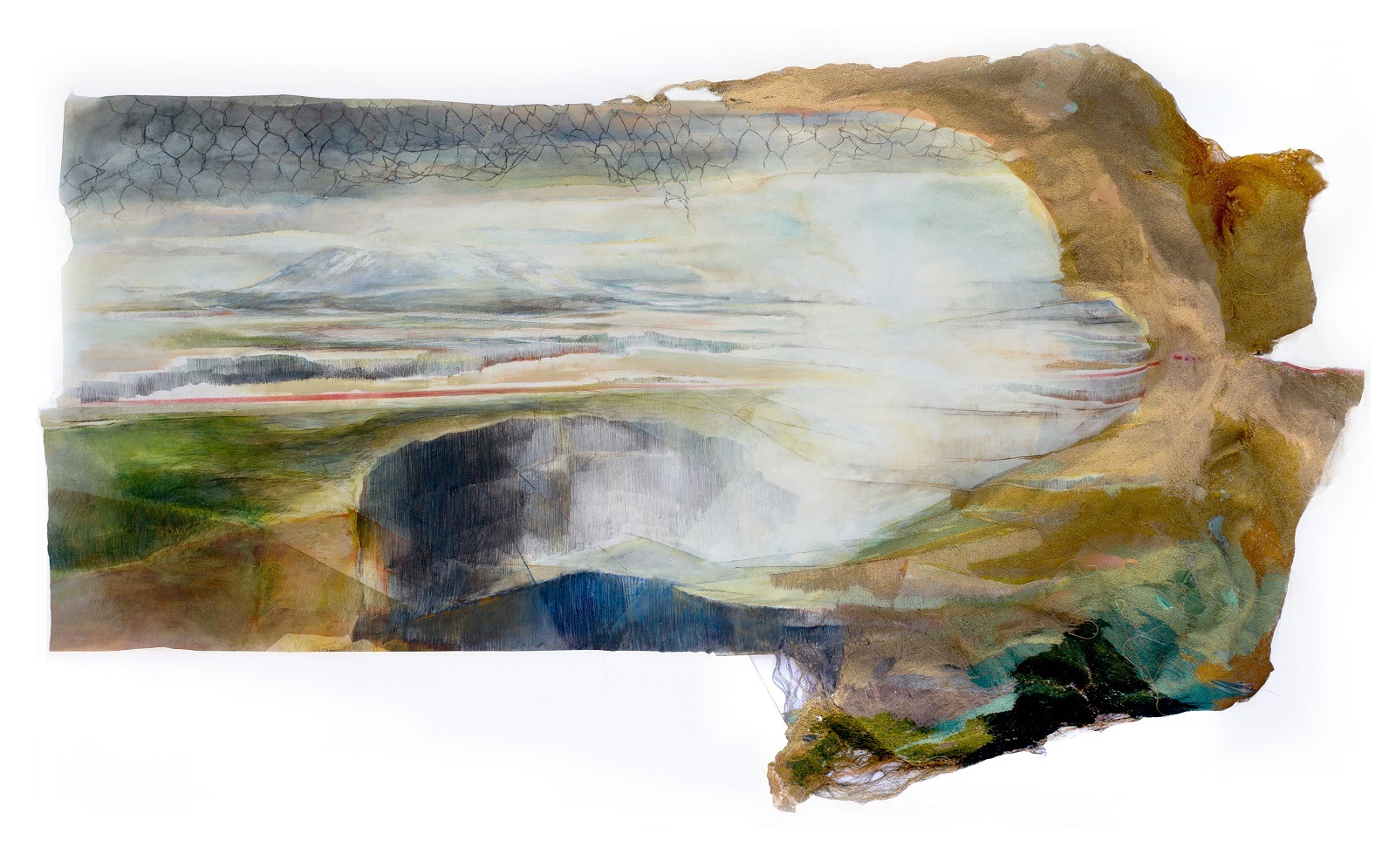
What or who were your early influences and how has your life/upbringing influenced your work?
Textile art was not so widely known twenty years ago, and certainly not in in Portugal. I remember how shocked I was when I first saw contemporary artist Gada Amer’s work. I loved her use of thread as a drawing tool to produce tactile dimensions, and how she used hanging wires, chains and wefts. These and the graphic qualities of her works had an irreversible influence on my work.
In my first experiments integrating textile art with painting I used thread to reconstruct what had been torn apart, to link the narrative layers. The stitches acted like sutures. At the time I only used hand stitch, in an almost brutal way. Moving to Brussels and my experience working in La Monnaie opera house brought about a lot of changes.
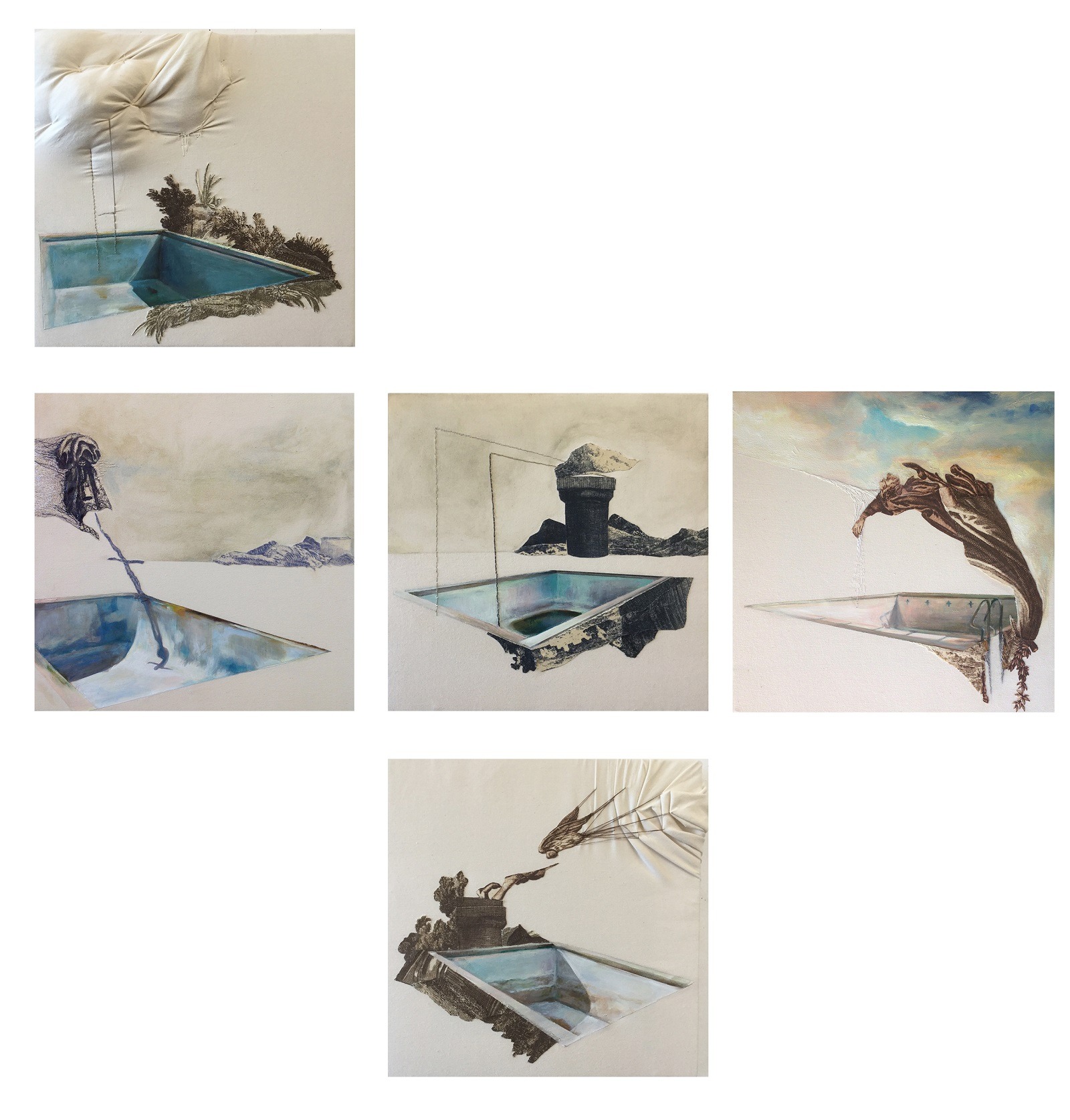
What was your route to becoming an artist?
Fine Arts was always my one and only path. During my education, my development had been easy, natural and linear. When my studies finished, the questioning began; “what is my artist statement, and how will I express it?”
My experiences living as an expatriate in Belgium opened many doors for me. Brussels is such a vibrant city of culture and diversity. Arriving from Portugal, a bold new world opened up in front of me as I began my studies in the Textiles Department at the Academy of Fine Arts in Brussels. And my experiences in the set décor studios of the La Monnaie opera house reinforced further my attraction to the world of textiles. The opera house was such an enriching environment to be immersed in, and this is where I first learned to work with an industrial sewing machine. I spent whole days buried and enshrouded in magnificent and gigantic velvet curtains that we made at the request of the stage designer. I experienced the wonders of tulle transparency and opacity, and the miracles of lighting. I saw the potential of fabrics as a medium for sculpture and visual installation, and I discovered wonderful “drop-paper” now used, fifteen years later, in my “Rebel Skins” series.
During that time I developed my personal art practice, integrating patchworks of fabrics and embroidery over my painting. It was not easy to find the right balance, especially when the work is essentially figurative. There is always a risk of overdoing it, so simplification is one of my main objectives. The idea is always to work within a new fluid language of process, with each method so united that we no longer see the two techniques being mixed.
Observe, reinterpret and create. This is my mantra.
My subjects developed in other directions as the textile work took over. The textiles themselves became the source of inspiration, the subject and theme. For example, toile de Jouy fabric was the starting point of my series of works “Monsters”. I dissected these historical fabric patterns into their individual motifs, cut out figures, structures and floral ornaments and applied them to my painting surfaces. Spacious landscapes, abstract locations, impossible perspectives and empty swimming pools are painted on the canvas to provide a home for these anachronistic figures.
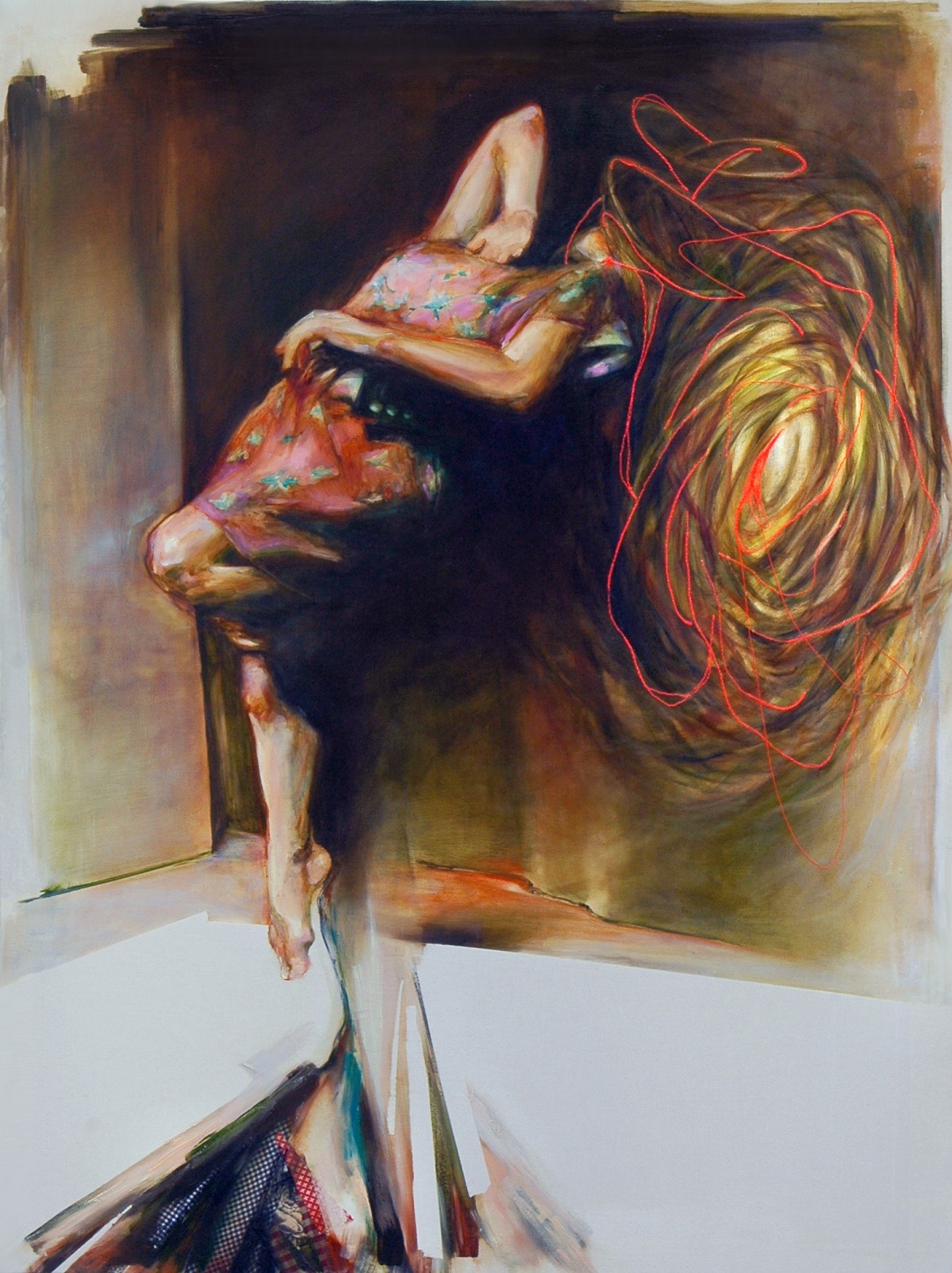
My “Dédale” series is also a good example of how the textile itself has become a theme and concept of work, as well as the technique. At that time, I was using thread as a pictorial element in the same way as you would with oil brushstrokes. First the thread was my material, then it became my technique for representation; thus moving the thread from a role of medium to content. This mimetic game with the thread led me to create a series of works that I called “Dédale” from the Greek mythological figure Daedalus, creator of the labyrinth. The chaotic tangles of thread that served me as pictorial brushstrokes transformed into models of timeless still lives, enigmatic characters, swirling skies and human excrescences, growths or abnormalities. Dédale is all about the thread that binds the individual yarns, an evocation of the mythical Ariadne’s thread, used to aid escape the labyrinth and provide salvation in a seemingly hopeless situation.
One particular question has always occupied me: “Why mix painting and textile techniques?” Painting brings a sense of illusion and the effects of light, like a sort of waking dream. Textiles bring proximity, tactile desire and can invade the physical space of the spectator. So the question became a line of exploration; painting with textiles, painting the textile, paintings moving ‘out of the frame’ and invading the space, with textile growths and shapes protruding.
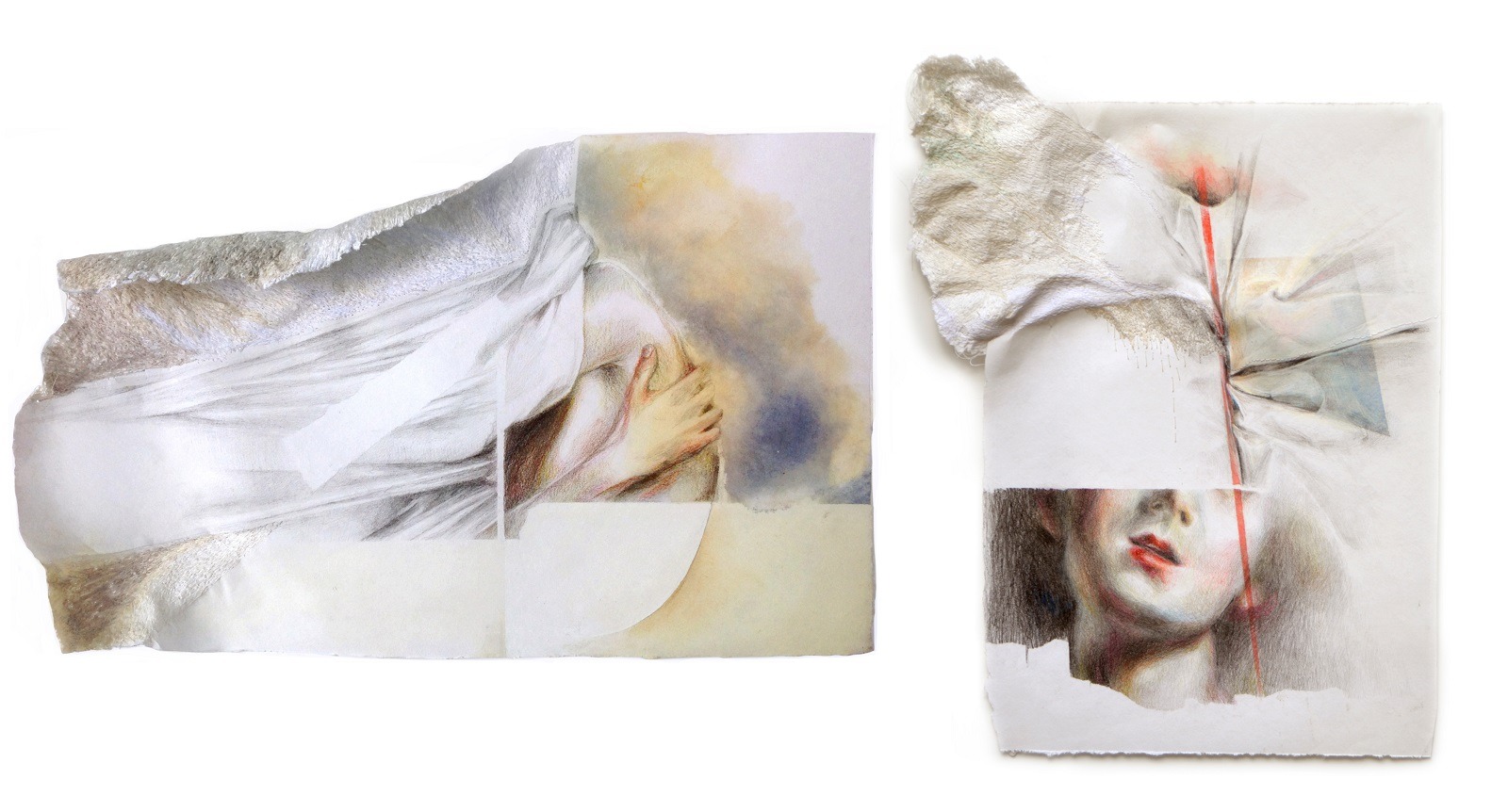
Creating “skins”
Tell us about your process from conception to creation
In 2018, I had the opportunity to move to a large studio and I was finally able to open and explore all the boxes and files I’d stored. That’s when I rediscovered “drop paper”. It’s a fibrous, non-woven paper that I had worked with at the opera house. It is solid, almost unbreakable, which is why it’s used in scenography and architecture.
Experimentation is always the key. First I tested the paper as a drawing medium, trying a few stitches of hand embroidery. Little by little I added painting techniques to the drawing, and then the manual stitch gave way to the sewing machine.
This new medium offered me a giant step forward in my search for a fluid dialogue between painting and embroidery. The fibrous paper tames the scars and tension created by stitching layer after layer. Slowly the yarn transforms the paper into fabric. Being organic and flexible this new material lends itself to three-dimensional forms. The needle and thread is no longer used like a pencil but more as a loom, creating a new ‘skin’ which rebels and eventually pulls itself away from the paper. My work on paper takes on a life of its own; shapes, curves and forms appear, generated by the movement of the free machine stitching.
Independently of the medium, my work always explored an invisible territory of emotions inspired by an embedded fascination with the body, childhood, places, memory and uprooting. The body is singled out, fragmented and constrained, while the landscapes are tamed until they become immobile, by grids and structures.
Most of the time, I let myself get inspired by an image, a place, or a body. Then I make preparatory sketches and collages in a fairly basic way. I want to keep the idea fresh in my head and use a good deal of improvisation. I prepare the canvas or the paper, drawing and painting while already imagining where and how the stitching will intervene. The graphite pencil and oil pigments intertwine, ready to accommodate the rumblings of the machine. The delicacy of the drawing combines perfectly with the resilience of the drop paper.
At the moment I am very focussed on my work on paper because it allows me to achieve the fusion and three-dimensions I’ve sought for a long time. Working outside of a traditional format, I can be guided by the tension-folds formed randomly by the sewing machine. And by closely observing the results, I can gradually start to manipulate the randomness, to obtain my desired shapes and volumes. By using this technique, I created the series “Rebel skins”.
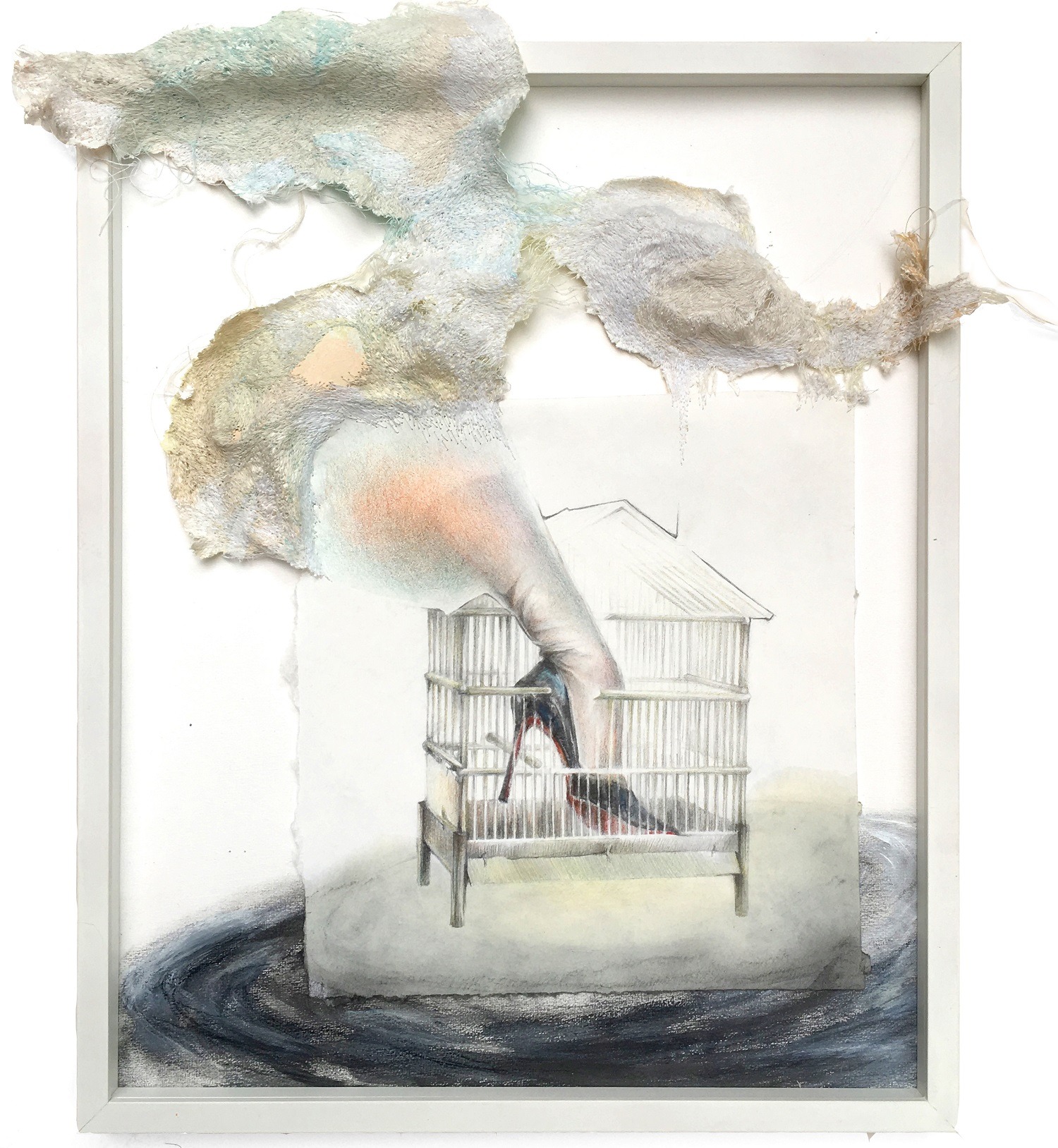
Tell us a bit about your chosen techniques and how you use them
For my work on canvas, the oil painting comes first. I use the traditional technique of glazing because it allows an illusion of lightness, light and depth. It creates a smooth surface, like a mirror, that contrasts well with the texture and warmth of the threads. I sometimes work for weeks on the painting before I pass it through the sewing machine. I have no room for error at this stage, which brings an additional artistic dimension!
Sometimes I start with a patchwork of fabrics such as cotton, linen, damask, gingham, or checked fabric and then I prepare the parts I want to paint. In these works, the colour, texture and pattern of the fabric have the same importance as the painting.
My other fetish fabric is toile de Jouy. These prints allow an interesting link between painting and printing. Many are classical drawings from the eighteenth century and I use them to play with anachronism, cutting out the figures and sticking them on the painting.
After this comes the embroidery, using both hand stitching and free machine embroidery. Free machine stitch has evolved my work; the thread is no longer just a drawing medium, it’s a painting medium and a fabric creator.
As you can imagine, using a sewing machine in free stitch mode over a painted canvas throws up technical problems. The tension of the machine causes pleats on the painting and it’s really difficult to pass a canvas through the small arc of the sewing machine. For the first eight years I used a consumer Bernina-machine and it was a very complicated process trying to get the stitching to work. Thanks to the textile artist networks, I was advised to use a semi-professional machine adaptable to quilting. It changed my life! I still get a few folds in the painted canvas but I take advantage of that feature. With my work on paper, these same folds are the basis for the creation of volume and shape in my “textile skins”.

What currently inspires you?
I love the combination of paper and thread and all its possibilities. Nature, light, texture, and all shades of green inspire me, as does good art including cinema, contemporary dance, and art made by my students.
The proliferation of textile art and seeing it raised up to the rank of Fine Arts stimulates me. Knowing that so many artists use textiles in original and personal ways is very inspiring.
It’s amazing that contemporary art fairs (like Art Up Lille) put textiles right in the spotlight, inviting me to display my work. This is very comforting and motivating!

Going large-scale
Tell us about a piece of your work that holds particularly fond memories and why?
Several pieces are particularly important to me, for very different reasons.
“Paint Me” is a work that I had in my possession for a very short time. It was the last work I made for the exhibition “Sous tension” in 2015. I finished it just a week before the exhibition, and it sold very quickly, bought by a collector who was unable to wait until the end of the exhibition. But I didn’t choose it only for this reason; the work is the metaphor of my artistic research and I think it doesn’t require an explanation. It also marked the beginning of an irrepressible desire to get “out of the frame” which gradually led me to my current work practice.
“Paysage interrompu” is a very recent work from 2019. It is in my studio waiting to be sent to Contextile 2020 in Portugal, in September. This is my most textile and sculptural work so far. The landscape is omnipresent, allowing itself to be dominated by the barbed wire that runs through it, like a delicate ornamental motif. It is the imaginary horizon of an inaccessible territory, a half-opened window towards a place of memory. It also integrates the concept of “recto/verso” that I’m developing at the moment to explore which is the front side and which is the back side? Another ambiguity, which is a recurrent theme of my entire body of work!
“Mariage forcé” or “Transversus” is a work in progress, started in 2017. It is important to me for a personal and emotional reason because it is a collaboration with my mother, Joaquina. It was one of my first attempts to create an installation, a “dress”. I wanted to share with her the pleasure of making lace for artistic reasons, rather than for old fashioned, decorative intentions. It was a challenge to encourage her to make lace not respecting traditional patterns! This work has been evolving for almost four years, and is continuing to weave and grow, always in collaboration with my mother.
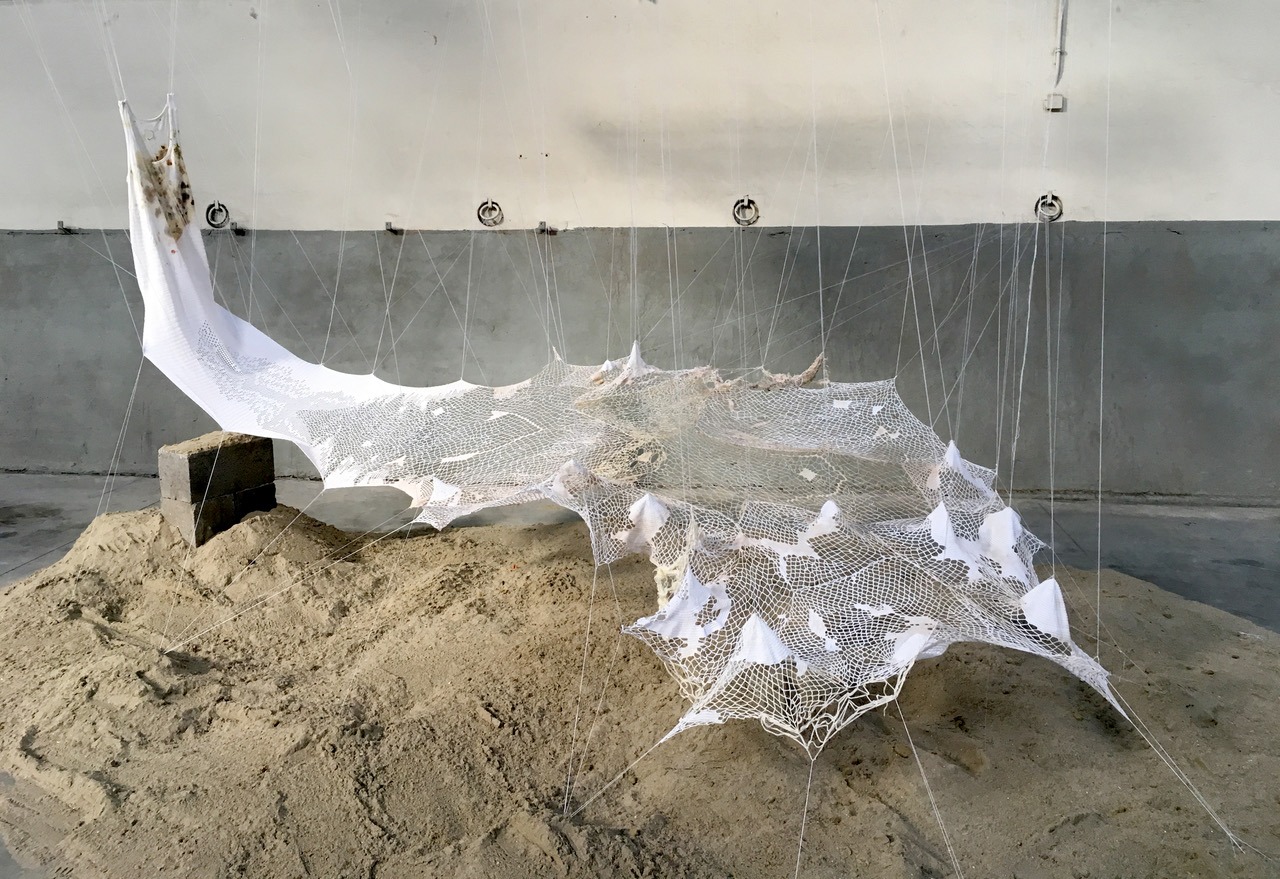
Very recently, I was invited to join an artistic residency with “Espirito Mundo”, based in Brussels, in order to co-create an exhibition made of pieces created and/or recontextualised collectively, along with eleven other artists. Here “Mariage forcé” became “Transversus”, a new installation and performance creation. In this exhibition “Tanto Mar / Tant de Mer”, “Transversus” presents itself as a metaphor for human and transatlantic interconnections. A crossing of places, thoughts and subjective territories. The body is omnipresent and the “dress” becomes a kind of skin that protects and traps. Its network is a topography of the imaginary, which unfolds and describes a trajectory of movement and physical gesture, the traces of time, and an initiation of emancipation.
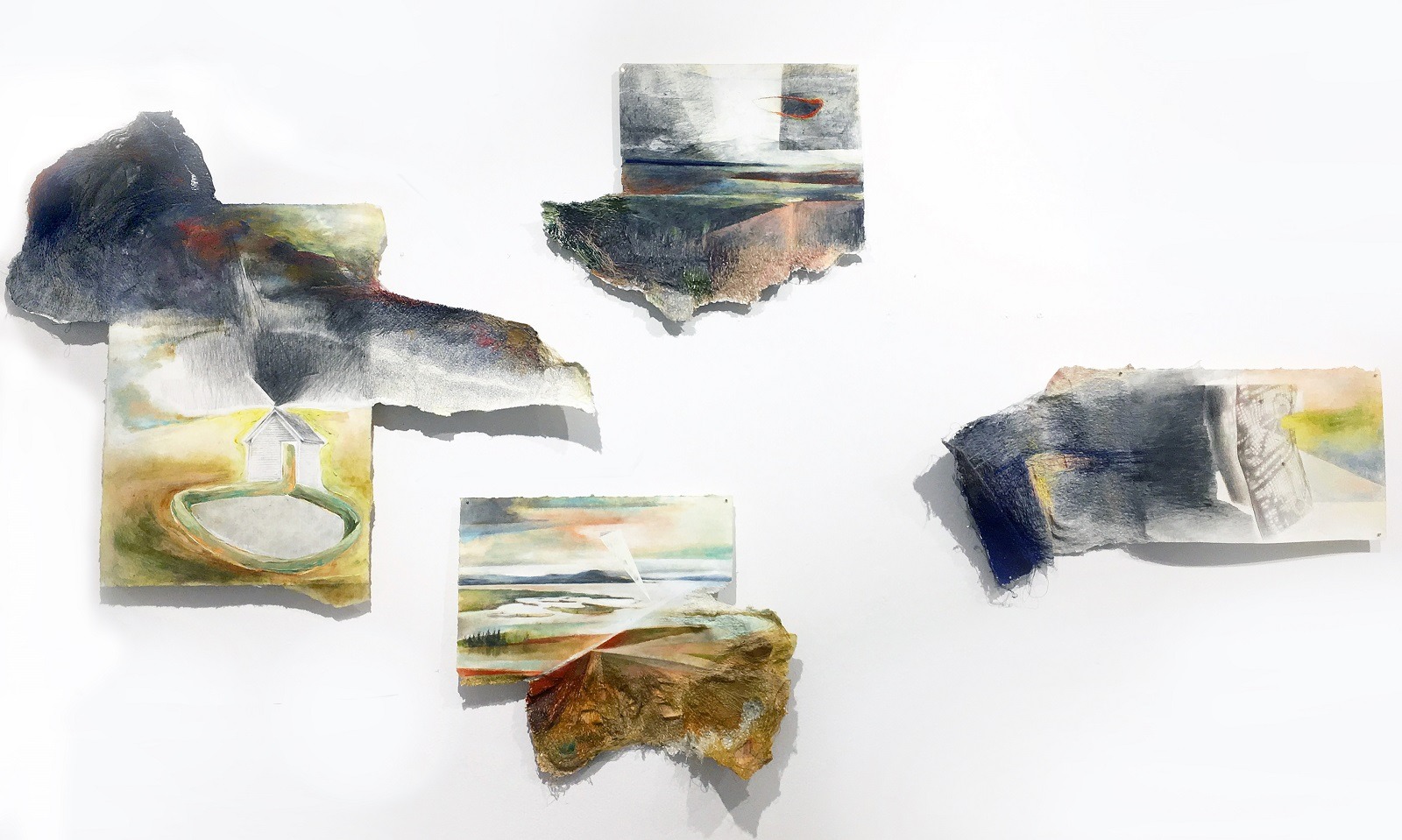
How has your work developed since you began and how do you see it evolving in the future?
I have many ideas, so I write them down for the future. I feel like I am the right path to explore my goal in a relevant way. With every piece, I learn something new. I become more confident in this exploration of my mixed media.
Today, I am more patient than when I first began. I feel more at peace. I try to give more time to reflect on each piece. I often set an artwork aside and wait for a time that it will “speak” to me.
My next challenge is scale. I would like to work on monumental-sized formats! The technical constraints due to the small arc of the sewing machine are less present with paper than with canvas. Furthermore, sewing with paper gives me the possibility to add more material during the sewing process and keep enlarging the format during creation.
There is no longer a conflict between my two mediums, and this allows me to target more daring works. I like to play with my work in its exhibition space, and this is leading me towards creating more installations and site-specific projects.
I am also developing my skills on landscape themes to work in a more abstract and atmospheric way, and then modify the results using textural free machine stich. I would like to integrate other textile techniques, for example hand stitch and weaving.
I would also like to intensify my collaboration with other fiber artists, digital media artists, writers and performers. My recent experience of co-creation in the context of artistic performances was extremely enriching. To create or to re-signify a work according to the presence and the gestures of the human body interests me a lot. It is my wish to continue exploring this path.
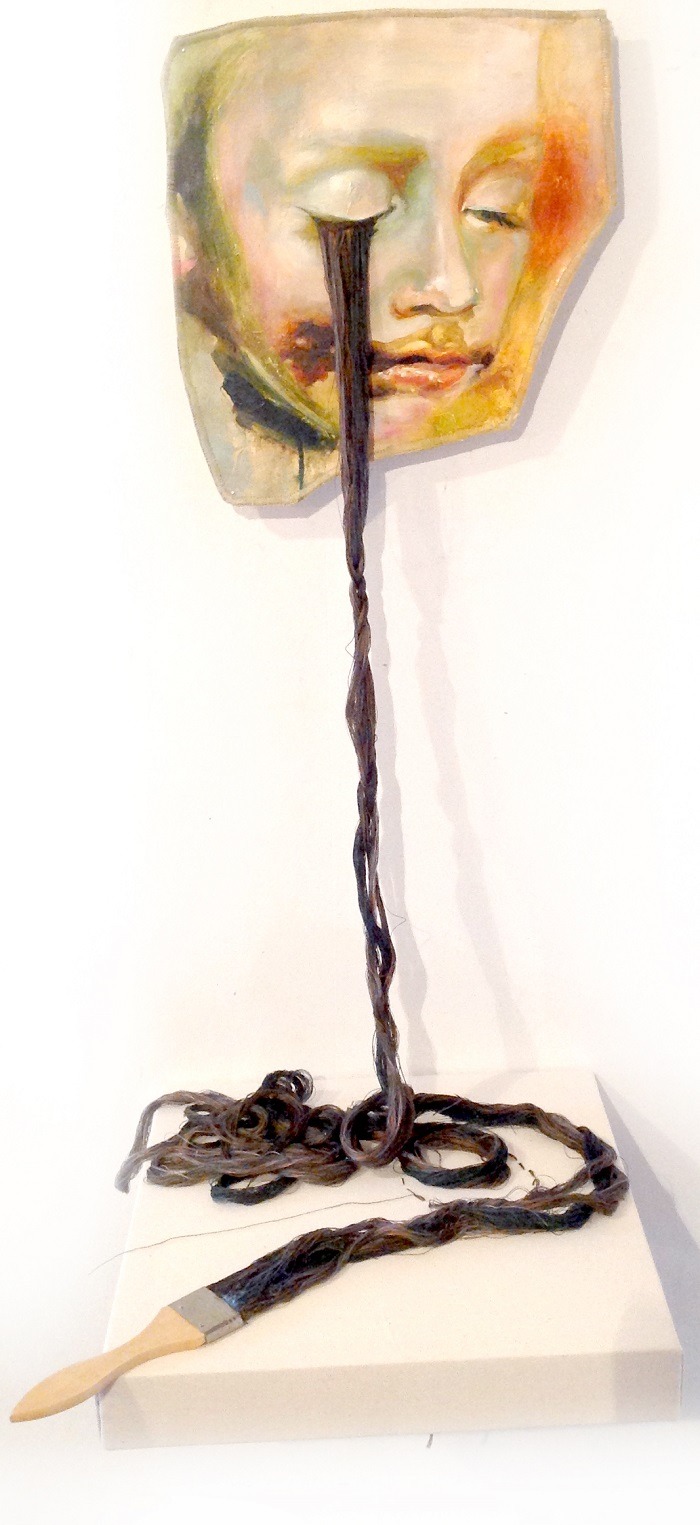
What advice would you give to an aspiring textile artist?
Always try to enjoy making your art! It must remain a pleasure. This is something I often tell my students. Make time for your art. In my experience, it often takes a few attempts to get the artwork where you want it to go. And don’t forget the joys of testing and experimenting.
Keep in mind that the process is more important than the result. You must trust your instincts and your creativity but remain a critic of your work. Persevere and don’t take failures too seriously. Bad reviews of your work should not be seen as a personal attack, so protect yourself and keep going. Relish your big and small successes.
Be organised and keep track of all your works and projects (I regret that I haven’t always done this).
Stay curious and immerse yourself textile art and all art in general. There are so many good things to enjoy and inspire!
For more information visit www.sonia-aniceto.net
Share this artist’s work with your friends on social media. Click on the buttons below!
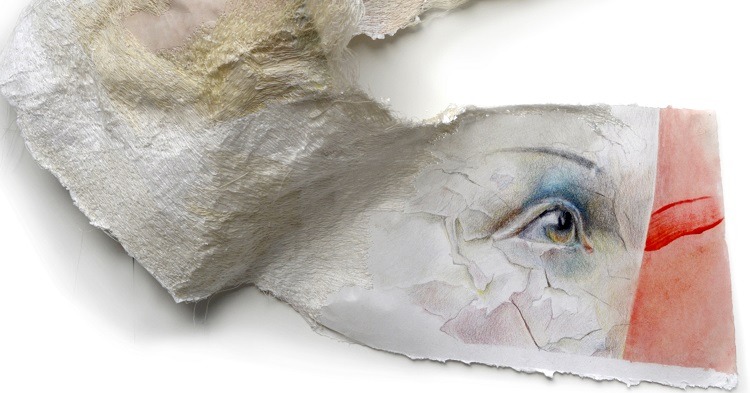

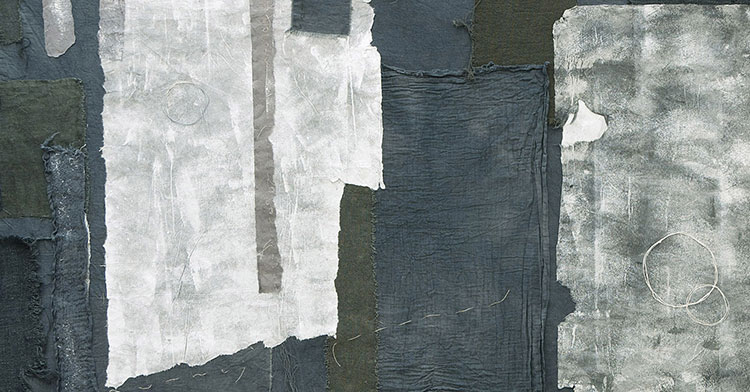
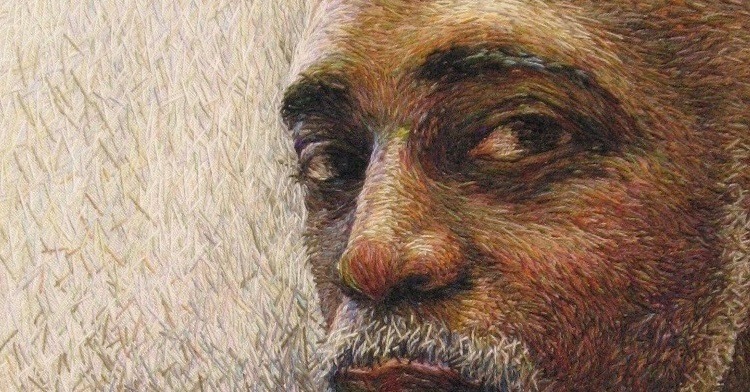
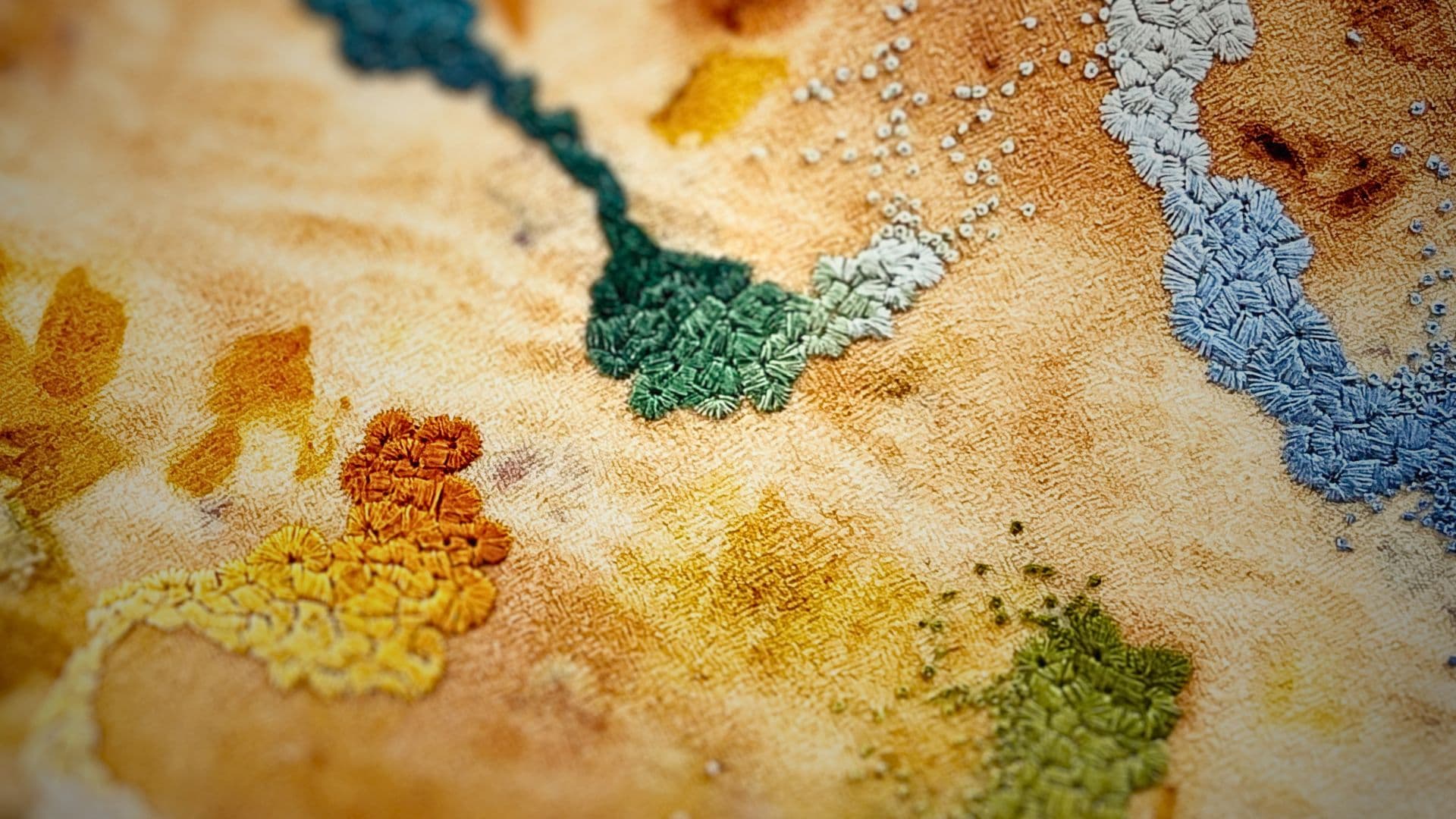
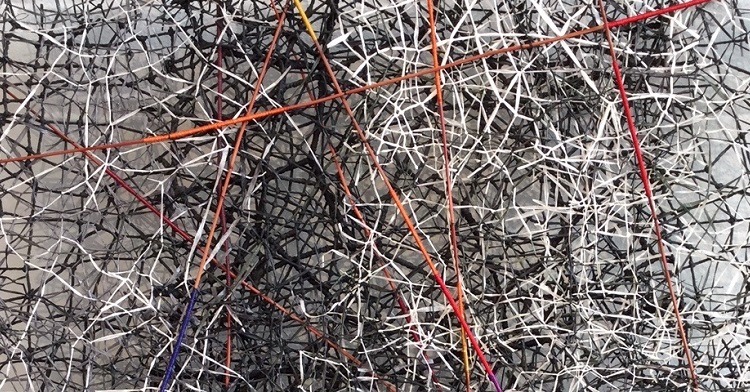
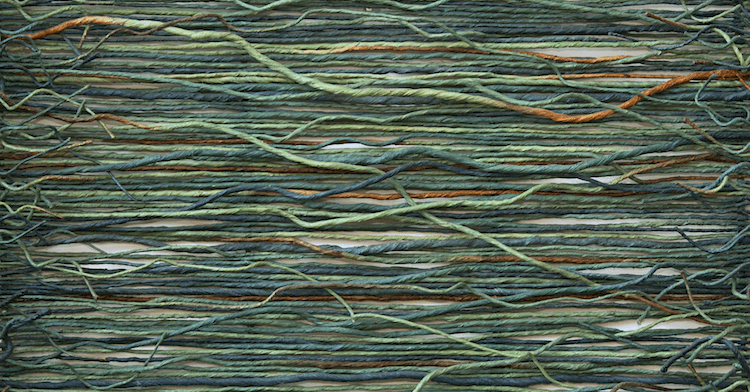
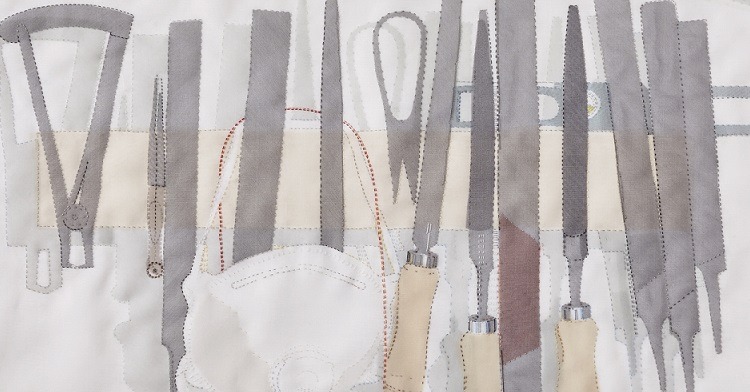
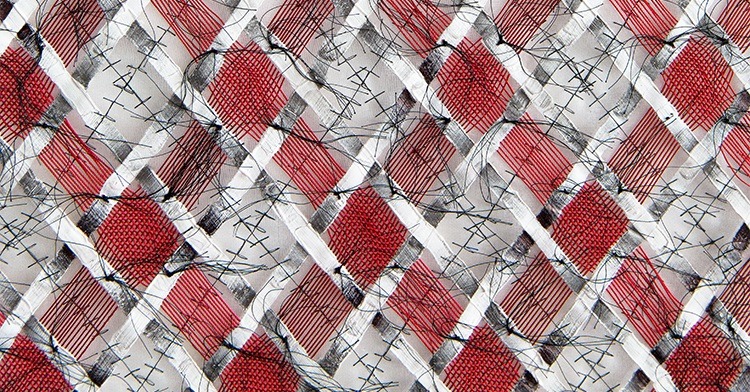
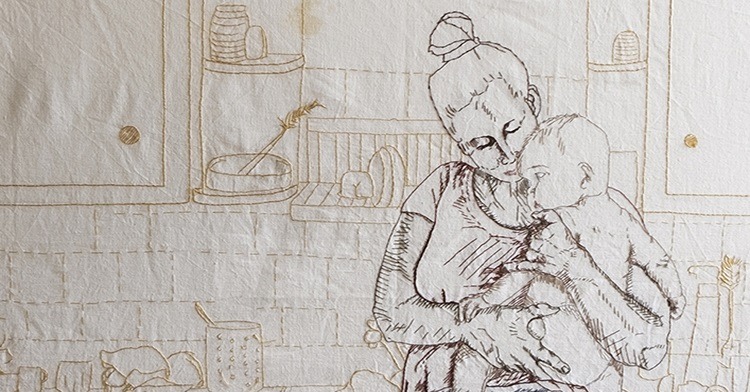
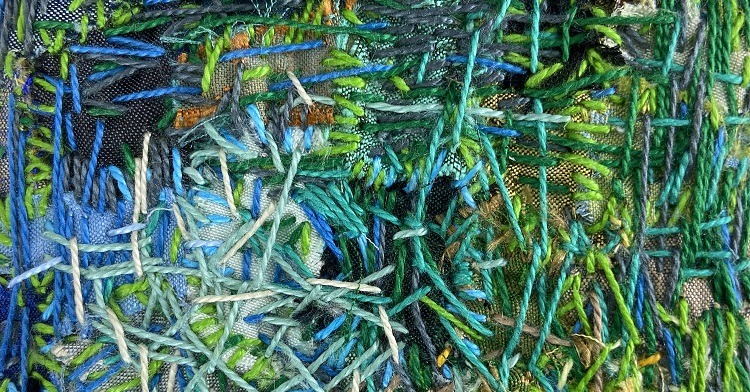
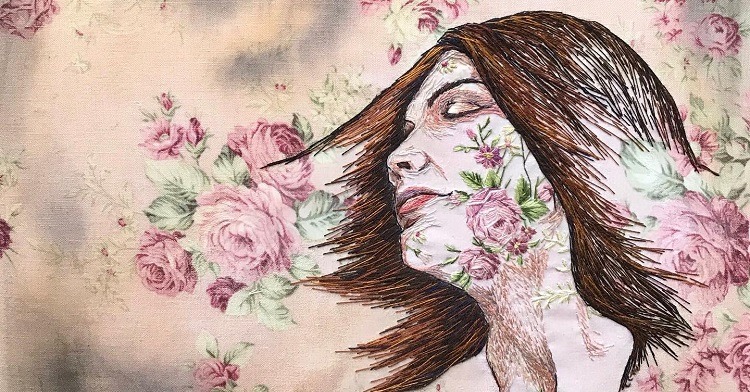
Comments